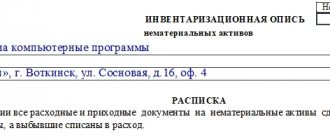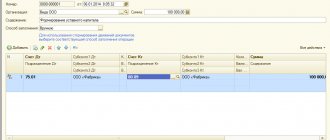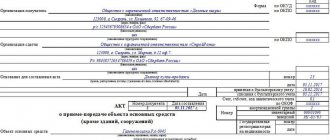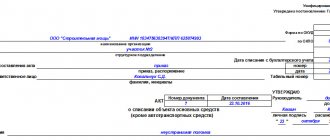All intangible assets owned by the organization are subject to accounting. In order to record the fact of their ownership, there is an intangible asset accounting card.
- Form and sample
- Free download
- Online viewing
- Expert tested
FILES
Intangible assets may include licenses, trademarks (exclusive rights to use something), databases and other information objects of intellectual property.
The legislative framework
The document was adopted by Resolution of the State Statistics Committee No. 71a of October 30, 1997. There is a footnote to this effect in the paper itself in the upper right corner (it also states that the card has been assigned the interindustry form NMA-1).
In 2013, all forms of primary documents became recommendations. For this reason, when creating a document, deviations from the given forms are allowed. Each such change must be justified and documented. The form remains in use due to the conservatism of the organizers of enterprises, as well as because of its informativeness and convenience.
How is documentary accounting of intangible assets maintained?
Each fact of economic life must be documented in a primary accounting document (Part 1, Article 9 of the Federal Law of December 6, 2011 No. 402-FZ). Therefore, the receipt of an object of intangible assets into the organization is formalized by a document for capitalization. But a feature of an intangible asset is its long-term use (at least for a period of more than 12 months), therefore it is necessary to ensure control of the condition and availability of the intangible asset during its useful life. Such control is carried out over inventory items, which are accounting units for intangible assets (clause 5 of PBU 14/2007).
Let us recall that the inventory object of intangible assets is a set of rights that arise from one patent, certificate, agreement on the alienation of the exclusive right to the result of intellectual activity, etc. Moreover, each such object must be designed to perform certain independent functions. In some cases, the inventory object of intangible assets may be recognized as a complex object that includes several protected results of intellectual activity (for example, a movie, theatrical performance, multimedia product).
Resolution of the State Statistics Committee dated October 30, 1997 No. 71a approved the form of the Intangible Asset Accounting Card (Form No. NMA-1). This form is intended for current object-by-object accounting of intangible assets.
Components of the card
The paper is filled on both sides. On the title side there are:
- Title of the document;
- his number;
- OKUD code;
- OKPO
After this data, in the first lines of the card, you must write down the full name of the company itself, as well as the department in which the document is being filled out.
At the end of the introductory information there is a small table for filling in the date of compilation, transaction code, date and number of the described intangible asset.
Attention! In the vast majority of cases, the object of intangible assets is described in a single copy. This is indicated on the form itself; at the beginning there is space for one name.
Below are two tables to fill out. The first should provide data on:
- structural unit;
- the type of activity specified in the described intangible asset;
- account number;
- analytical accounting code;
- book value;
- period of use;
- volume of financial depreciation;
- estimated rate, percentage of depreciation rate;
- account code and the code of the accounting object itself;
- registration deadlines.
The second table is more extensive and includes columns such as:
- method of acquiring an intangible asset;
- description of the registration document;
- for what reasons, when and at what price it left.
At the very end, a separate line mentions the amount of depreciation of the intangible asset.
Intangible asset registration card: sample filling and form
We will briefly describe the procedure for filling out an intangible asset card using a unified form, and also give an example of how to fill it out.
Form No. NMA-1 is kept in the accounting department for each object in one copy on the basis of documents for capitalization, movement of intangible assets and other documentation. In the section “Brief description of the object of intangible assets,” only the main indicators of the object are recorded in order to eliminate duplication of data from the technical documentation for the object of intangible assets.
NMA-1 cards in RTF format can be found here
Let's give an example of filling out form No. NMA-1 in relation to an advertising video produced for an organization by a third-party supplier and not depreciated due to the fact that the useful life cannot be reliably determined.
Reverse side of the intangible assets accounting card
There are no tables on the second page of the document. On it, the filler is provided with lines for a brief written description. Moreover, the purpose of the asset is not stated in it, since it should already be contained on the front side of the document.
You can specify here the specific parameters and capabilities of the computer program, terms, and rights. A list of functionality will also be useful. They often list the company whose intellectual property the product was. But too lengthy a description is not welcome.
Important! Information on the brief characteristics should not duplicate or quote technical documentation (instructions, operating rules) for the described object, which is located in the organization.
The final touch on the paper will be the indication of the position of the person filling it out, his personal signature and transcript. It is placed after a comprehensive analysis of the intangible asset.
Sample of filling out an intangible assets accounting card
NMA-1 is drawn up in 1 copy. The basis for entering data into it is a document that may indicate receipt of the asset. A separate card should be created and filled out for each intangible asset.
The header of the form provides information about the enterprise and its structural division. After this, the date of registration and the name of the intangible asset are indicated.
In general, IMA-1 is a table consisting of 17 columns that reflect the main characteristics of the asset:
- accounting account (column 3);
- initial cost (column 5);
- useful life (column 6);
- depreciation amount (column 7);
- depreciation rate (column 8);
- document on the basis of which the intangible asset was accepted for accounting (column 12);
- information about the disposal of the object (columns 13-17);
- other information.
When filling out information about disposal, you must indicate the reason for writing off the asset, as well as the amount of proceeds if it is sold. After the table the amount of depreciation is entered.
The last stage in document preparation is to reflect brief information about the intangible asset. When the basic information is entered into the form, the person in charge signs the card, indicating the date of completion and position.
On our website you can form NMA-1:
The NMA-1 intangible assets accounting card is used in many enterprises that have the corresponding non-current assets on their balance sheets. To correctly reflect transactions related to the use of such property, it is necessary to comply with the rules for documenting its receipt, use and disposal.
Subtleties of filling out the card
Responsibilities for filling out and maintaining all accounting cards in proper form rest with the accountant. In the vast majority of cases, it is this employee who signs the final part of the paper. Information to be filled out can come from acceptance certificates, various documents for the posting of the described assets.
Attention! A separate card is drawn up for each item of intangible assets.
Then they are all entered into the general register of cards, and a general statement is formed for all compiled documents.
Why do you need an NFA acceptance certificate?
The document in question was put into circulation by order of the Ministry of Finance of the Russian Federation dated March 30, 2015 No. 52n - the main regulatory act that approved the use of various unified forms by institutions of the budget system of the Russian Federation.
The act of acceptance and transfer of non-financial assets form 0504101 is used when recording the movement of relevant assets between various legal holders and users:
- as part of the transfer of an asset to the operational management of an institution or economic management;
- as part of the transfer of the NFA to the treasury;
- in the process of repossession of an asset by the owner;
- upon transfer of an asset used to finance the authorized capital;
- during the sale of property of a budget system organization.
Read about what NFA is here.
You can learn about the latest changes in budget accounting and new standards that have been applied since 2021 from the Review from ConsultantPlus. If you do not already have access to this legal system, a full access trial is available for free.
Possible mistakes
Loan costs should not be included in the initial cost of the asset. This may include:
- costs of attracting specialists (both internal and external);
- price of materials;
- depreciation of environmental protection;
- patent fees.
But not loans or credits.
If a company has acquired software, and its copyright holder is another organization, then such an asset cannot be registered in the intangible assets accounting card. This only occurs if the exclusive rights to that specific software product or license are transferred.
You should not issue an intangible registration certificate (NMA-1) for the rental service of any program. These cases are noted only on the off-balance sheet account according to the agreement number, which stipulates the relationship of the copyright holder with the user.
Important point! The useful life of the program or license must be reviewed annually.
The same applies to the calculation of depreciation (in particular, the method of carrying out this calculation). It is worth noting that there are intangible assets with an indefinite useful life. They require confirmation each year for factors that prevent these deadlines from being established.
Form of intangible assets accounting card
The intangible assets accounting card NMA-1 was approved by Decree of the State Statistics Committee of the Russian Federation dated October 30, 1997 No. 71a.
The primary information entered into this form indicates that intangible assets (intangible assets) have been registered. At the same time, the legislation on accounting allows business entities to draw up their own primary forms for accepting intangible assets, but preserving all the necessary details.
For information on what constitutes a primary document, see the article “Procedure for organizing primary accounting.”
Intangible assets accounting card: form NMA-1
Being a primary document, an intangible asset registration card is drawn up upon receipt of an object. The standard form approved by Goskomstat is universal and until recently was mandatory, but since 2013 business entities have been allowed to develop their own documents, maintaining all the necessary details. Note that the intangible asset form - 1 is very convenient; it was developed by analogy with the asset accounting card, and companies use it, including additional sections only when they are necessary due to the specifics of production.
Filling out form No. NMA-1
Drawing up a document is a simple operation, but there are rules that guide it:
Each registration card is assigned a registration number in the line “Card No.”, the date of drawing up the document and the acceptance certificate, the full name of the company, OKPO code, as well as the division (shop/department) where the facility is operated are indicated. However, based on the intangibility of property, it is usually used in the activities of an entire enterprise, for example, a brand or trademark of a company, and then there is no need to fill out the line “Structural unit”.
For enterprises using a coding system, the transaction code for the receipt of the asset is entered on the card, and then the date and number of the corresponding document are specified. Subsequently, information is entered about the type of activity for which the asset was acquired, the department responsible for operating the asset, and the balance sheet account (subaccount) in which it will be recorded.
All object parameters are indicated:
- the initial cost, which consists of the costs of purchasing and bringing it to usable formats;
- the period required for full depreciation of property (SPI). Often, SPI is determined by expert means, since a special classifier has not been created, and the specifics of these assets are not always amenable to traditional methods of calculating depreciation. For intangible assets whose useful life is not determined, depreciation rates are set for ten years;
- depreciation rate in % or estimated rate;
- monthly depreciation amount;
- an account in which accrued depreciation amounts are accumulated.
For objects for which depreciation is not accrued (for example, received under donation agreements), dashes are placed in the corresponding columns.
The column “Acquisition method” provides information on how the company acquired the assets. Column 12 “Registration document” contains information about the document confirming the right to use intangible assets.
The last block of the table is devoted to information about the disposal/relocation of an object: document number and date, reason for disposal, amount from the sale of the object.
In the lower right corner of the form, in the “Depreciation amount” detail, the amount of monthly deductions is indicated.
The reverse side of the card is devoted to a brief description of the main qualities of the object.







